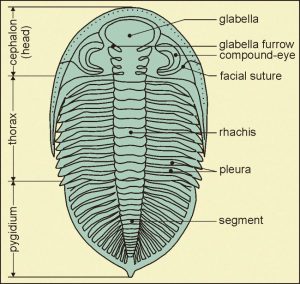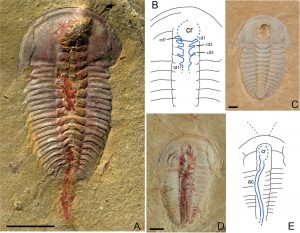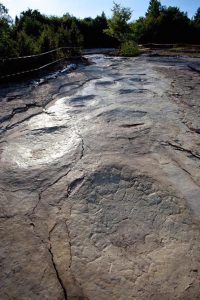I came across a couple of interesting stories detailing new discoveries in the field of paleontology. The stories concern my two favourite kinds of extinct animals, dinosaurs and trilobites so I have to talk about them.
I’ll start with the article about trilobites. For those who aren’t familiar with these creatures from the beginning of multi-cellular life trilobites are arthropods, similar to crustaceans, spider and insects but much simpler in physiology. (See picture below showing trilobite anatomy) Trilobites lived from the beginning of the Cambrian period (about 550 million years ago) until the mass extinction at the end of the Permian period (about 250 million years ago). During that long stretch of time over 20,000 different species are known to have existed so trilobites are a fairly common fossil; I have quite a few in my collection.

But usually trilobite fossils consist only of the hard outer shell of the animal, the internal anatomy has decayed completely away. Only rare specimens show any of the ‘soft parts’ of animals as old as trilobites. And since trilobites are one of the earliest forms of complex life their internal workings could tell us a lot about how the nervous system, or circulatory systems or other internal parts evolved.
Now a group of researchers headed by Melanie Hopkins of the American Museum of Natural History have published a paper describing the earliest known digestive system of a trilobite. The specimens used in the study come from the Guanshan biota in the Yunnan province of China, a location that produces fossils of exceptional preservation. The fossils used in the study come from two different species, Palaeolenus lantenoisi and Redlichia mansuyi, that are common at the site.
Multiple specimens were literally dissected, imagine dissecting an animal dead for 550 million years, in order find their stomach and trace their alimentary canal. In trilobites the stomach, also know as the crop, is situated very close to the mouth beneath the glabella, see picture above. The researchers also discovered pairs of digestive organs on each side of the alimentary canal, which runs nearly the entire length of the trilobite. The image below shows some of the dissected specimens along with drawings of what was found.

The digestive system of trilobites may seem simple compared to that of modern arthropods but for their time these were highly evolved. This study has given us some of the details about how the internal workings of a very important group of animals developed.
The second story I’d like to discuss comes from France where the longest known trackway of sauropod dinosaur footprints have been excavated in the Jura Mountains near the village of Plagne. The Jura Mountains by the way is where we get the name of the Jurassic Period.
The sauropod dinosaurs are the familiar long necked, long tailed plant eaters who were the largest animals to ever walk on the Earth. The 155 meter long trackway contains 110 steps and the impressions range from a little over a meter to three meters in diameter. The image below shows the trackway.

According to the ‘Societe des Naturalistes d’Oyonnax’, a local group of amateur paleontologists who discovered the footprints, the trackway was made by a single animal approximately 35 meters in length with a mass of around 35,000 kilos. The animal walked with an average stride of 2.8 meters at a speed of about 4 kilometers per hour. The image below shows an artist’s representation of the sauropod dinosaur walking along the trackway while humans are beneath it.

With each new find by paleontologists we are learning more about the history of life on Earth. It is a history far longer and more extensive than the history of the single species we think is so important.
